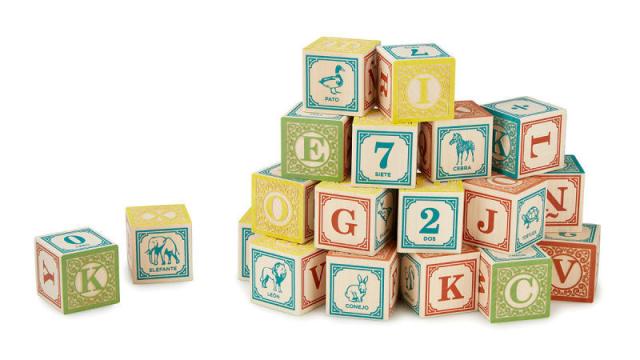The idea of teaching a child a second language can sound intimidating. If you, yourself, are rusty in that language (say, you haven’t conjugated a Spanish verb since Year 11), it can seem impossible.
Photo: Uncommon Goods
I have been a nanny for over 12 years. Despite being fluent in English and Spanish, I was completely overwhelmed the first time a parent asked me to teach their eight-month-old son some basic Spanish language skills. How do you teach a baby not only their first words, but their first words in two different languages? But I took up the challenge because I know firsthand the benefits of being bilingual. After all, this family had hired me on account of it.
[referenced url=”https://www.lifehacker.com.au/2013/01/how-to-successfully-learn-a-new-language-this-year/” thumb=”https://img.gawkerassets.com/img/18b2hgq2g9xmqjpg/original.jpg” title=”How To Successfully Learn A New Language This Year” excerpt=”Until the age of 21, I made several New Year’s resolutions to learn Spanish that never panned out. After I graduated from university (as an electronic engineer who could only speak English) I managed to spend an entire six months living in Spain without picking up more than just a few phrases. I was tackling it the way I imagine way too many people are tackling their learn-a-language resolution this year. Today, I’m a successful language learner myself, having studied over two dozen languages. I’m able to speak half of them well and about eight of them with genuine fluency. Hopefully some suggestions here will make sure you don’t make the same mistakes I made in my first years of doing it totally wrong!”]
I had discovered that the key to teaching a second language isn’t vocabulary, but consistency. Here are five ways to incorporate basic language skills into your child’s day:
Count Everything
In teaching Spanish to the little boy, I decided I would tackle counting first. At first, it was just me counting in between nappy changes or toys forgotten upstairs. I would count every step I took up and down the living room staircase. Soon, I was counting other activities and it became a sort of habit. I would count while getting him into the car seat, opening a book, or swinging on the swings. When he began to repeat it, I would count, “Uno… dos…” and allow him to shout, “Tres!” Later, I added more numbers, one at a time, holding out the sound of whatever number came last. For instance, I’d say, “Uno, dos, tres, quaaaatrooooo,” and he’d shout, “Cinco!” It was a game, and it worked! In no time at all, he was counting to 10.
In my opinion, counting is one of the easiest ways to introduce a new language. Make it fun and silly — maybe whisper the first numbers and shout out the last number on your count. You’ll be counting to 20 before you know it.
The Magic of Three
Someone recently told me that things that come in sets of three are easier for people to remember. I have found this to be very useful in teaching another language, even with babies as young as six months. Counting to three in any language is less overwhelming than counting to 10. Do it regularly — count stairs, Froot Loops in a bowl, or toys, three at a time, “Uno, dos, tres. Uno dos tres,” until you count them all. You can apply the rule of three to other things as well. Mum, dad, baby (mama, papa, bebe). Dog, cat, bird (perro, gato, pajaro). You can teach colours, places, and even the names of all your relatives. Use different tones in your voice, which will entice a child to watch your mouth as you say the words.
Nursery Rhymes
Music is universal. YouTube is a good outlet to find second-language nursery rhymes. Look for rhymes that repeat a lot, such as “Row Your Boat” or “Mary Had A Little Lamb”.
There are some nursery rhymes that are exclusive to certain languages and they sometimes aren’t translated. Check out those, too. For instance, in Spanish, a couple of popular ones are “Los Pollitos Dicen” (shown below) or “Tengo Una Muñeca Vestida de Azul”.
No matter which rhymes you go with, implement them at times your child is most likely to listen and engage with them, such as car rides, meal times or bath time.
Background Noise
Change the language on your TV every other week. This is both simple and effective. Even if it is not something your child is actively watching, if you have it on as background noise, the sounds of the language become familiar and will ease pronunciation skills later.
Greetings
You’re already saying “good morning” and “good night” to your child. If you learn these two phrases in a second language and use them regularly, it will become effortless. Once you have mastered these two greetings, add more to your palette — “good afternoon,” “how are you?”
You do not need a lengthy vocabulary to teach a language. It is taking the words you know and using them consistently that will help kids the most. Use this as an opportunity to learn or strengthen your second language. If you have friends with kids who speak the language, schedule as many play dates with them as possible. Having conversations with a native speaker with boost your child’s language skills, and as a bonus, you can begin some great friendships. Uno, dos, tres — go for it!

Comments